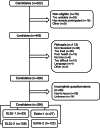CONECT-6: a case-finding tool to identify patients with complex health needs
- PMID: 33596929
- PMCID: PMC7891167
- DOI: 10.1186/s12913-021-06154-4
CONECT-6: a case-finding tool to identify patients with complex health needs
Erratum in
-
Correction to: CONECT-6: a case-finding tool to identify patients with complex health needs.BMC Health Serv Res. 2021 Apr 9;21(1):321. doi: 10.1186/s12913-021-06216-7. BMC Health Serv Res. 2021. PMID: 33836732 Free PMC article. No abstract available.
Abstract
Background: Early identification of patients with chronic conditions and complex health needs in emergency departments (ED) would enable the provision of services better suited to their needs, such as case management. A case-finding tool would ultimately support ED teams to this end and could reduce the cost of services due to avoidable ED visits and hospitalizations. The aim of this study was to develop and validate a short self-administered case-finding tool in EDs to identify patients with chronic conditions and complex health needs in an adult population.
Methods: This prospective development and initial validation study of a case-finding tool was conducted in four EDs in the province of Quebec (Canada). Adult patients with chronic conditions were approached at their third or more visit to the ED within 12 months to complete a self-administered questionnaire, which included socio-demographics, a comorbidity index, the reference standard INTERMED self-assessment, and 12 questions to develop the case-finding tool. Significant variables in bivariate analysis were included in a multivariate logistic regression analysis and a backward elimination procedure was applied. A receiver operating characteristic (ROC) curve was developed to identify the most appropriate threshold score to identify patients with complex health needs.
Results: Two hundred ninety patients participated in the study. The multivariate analysis yielded a six-question tool, COmplex NEeds Case-finding Tool - 6 (CONECT-6), which evaluates the following variables: low perceived health; limitations due to pain; unmet needs; high self-perceived complexity; low income; and poor social support. With a threshold of two or more positive answers, the sensitivity was 90% and specificity 66%. The positive and negative predictive values were 49 and 75% respectively.
Conclusions: The case-finding process is the essential characteristic of case management effectiveness. This study presents the first case-finding tool to identify adult patients with chronic conditions and complex health needs in ED.
Keywords: Ambulatory care sensitive condition; Case management; Case-finding tool; Chronic diseases; Complexity; Frequent user.
Conflict of interest statement
The authors declare that they have no competing interests.
Figures
Similar articles
-
Risk factors of hospitalization for any medical condition among patients with prior emergency department visits for mental health conditions.BMC Psychiatry. 2020 Sep 3;20(1):431. doi: 10.1186/s12888-020-02835-2. BMC Psychiatry. 2020. PMID: 32883239 Free PMC article.
-
Risk of Frequent Emergency Department Use Among an Ambulatory Care Sensitive Condition Population: A Population-based Cohort Study.Med Care. 2020 Mar;58(3):248-256. doi: 10.1097/MLR.0000000000001270. Med Care. 2020. PMID: 32049947
-
Profiles of Frequent Geriatric Users of Emergency Departments: A Latent Class Analysis.J Am Geriatr Soc. 2021 Mar;69(3):753-761. doi: 10.1111/jgs.16921. Epub 2020 Nov 6. J Am Geriatr Soc. 2021. PMID: 33156527
-
Factors associated with frequent use of emergency-department services in a geriatric population: a systematic review.BMC Geriatr. 2019 Jul 5;19(1):185. doi: 10.1186/s12877-019-1197-9. BMC Geriatr. 2019. PMID: 31277582 Free PMC article.
-
Characteristics and predictors of adult frequent emergency department users in the United States: A systematic literature review.J Eval Clin Pract. 2019 Jun;25(3):420-433. doi: 10.1111/jep.13137. Epub 2019 May 2. J Eval Clin Pract. 2019. PMID: 31044484
Cited by
-
Nursing Care Coordination in Primary Healthcare for Patients with Complex Needs: A Comparative Case Study.Int J Integr Care. 2023 Feb 2;23(1):5. doi: 10.5334/ijic.6729. eCollection 2023 Jan-Mar. Int J Integr Care. 2023. PMID: 36819614 Free PMC article.
-
Evaluation of Complexity Measurement Tools for Correlations with Health-Related Outcomes, Health Care Costs and Impacts on Healthcare Providers: A Scoping Review.Int J Environ Res Public Health. 2022 Dec 1;19(23):16113. doi: 10.3390/ijerph192316113. Int J Environ Res Public Health. 2022. PMID: 36498188 Free PMC article.
-
Medical complexity in emergency and urgent care settings: a scoping review protocol.BMJ Open. 2025 Jan 20;15(1):e086984. doi: 10.1136/bmjopen-2024-086984. BMJ Open. 2025. PMID: 39832999 Free PMC article.
-
Patient complexity assessment tools containing inquiry domains important for Indigenous patient care: A scoping review.PLoS One. 2022 Aug 31;17(8):e0273841. doi: 10.1371/journal.pone.0273841. eCollection 2022. PLoS One. 2022. PMID: 36044532 Free PMC article.
-
The CONECT-6 case-finding tool to identify patients with complex needs: A few tips to promote understanding.J Eval Clin Pract. 2025 Feb;31(1):e14129. doi: 10.1111/jep.14129. Epub 2024 Aug 11. J Eval Clin Pract. 2025. PMID: 39129340 Free PMC article. No abstract available.
References
-
- Blank FS, Li H, Henneman PL, Smithline HA, Santoro JS, Provost D, et al. A descriptive study of heavy emergency department users at an academic emergency department reveals heavy ED users have better access to care than average users. J Emerg Nurs. 2005;31:139–144. doi: 10.1016/j.jen.2005.02.008. - DOI - PubMed
MeSH terms
Grants and funding
LinkOut - more resources
Full Text Sources
Other Literature Sources



